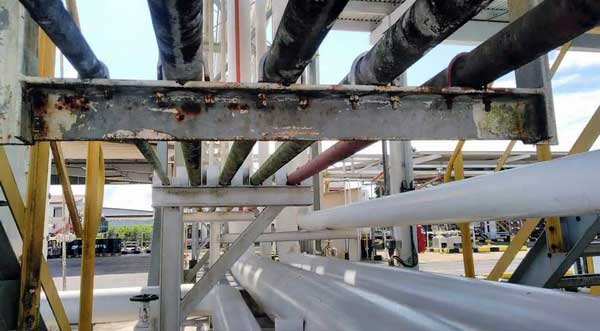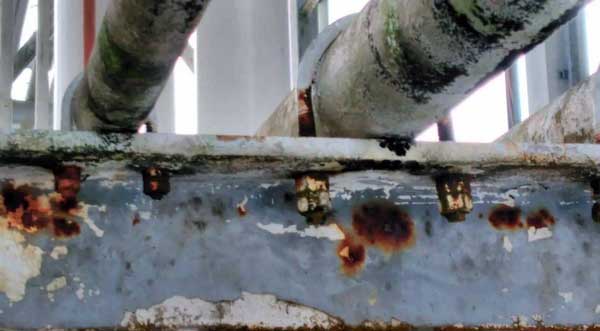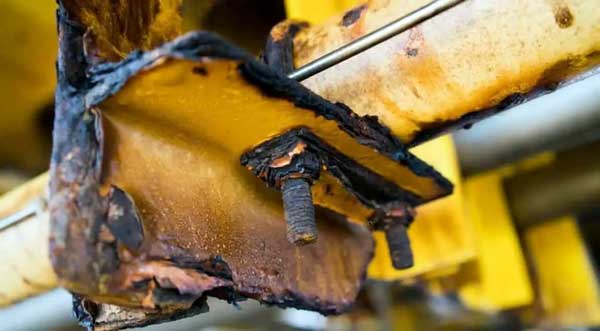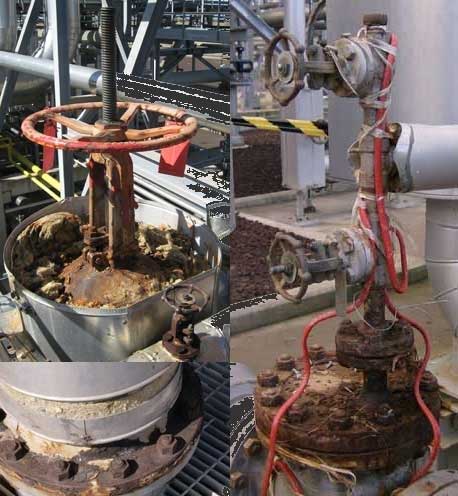 |
Corrosion Under Pipe Supports |
Corrosion under pipe supports (CUPS) is a serious problem in pipelines. It is important to detect and prevent this corrosion in order to extend the service life of piping systems and ensure safety for everyone.
CUPS is a widespread problem in the oil and gas industry, chemical processing plants, power plants, and the petrochemical industry. The natural process of corrosion that affects all metals and causes wear over time is present in all of the above sectors.

Corrosion under pipe supports, commonly known as CUPS, is a serious problem in industry because it affects the service life and safety of piping systems.
It occurs at the contact points between pipes and supports, where moisture and corrosive substances accumulate and cause corrosion.
This type of corrosion, which is difficult to detect during inspections due to poor visibility, can lead to unexpected failures, leaks, and serious incidents.
This article delves into the nature of CUPS, discussing and identifying its causes.
It also provides best practices for inspection, corrosion prevention, and maintenance.
The aim is to gain insight into how corrosion problems can arise in pipelines under supports and to implement effective mitigation strategies that are crucial for ensuring safety, reliability, and efficiency of industrial processes.
Forms and classification of corrosion
Mr.Fontana has classified the forms in which corrosion manifests itself. The basis of this classification is the appearance of the affected materials.
Fontana's eight forms of corrosion are: Uniform (or general) attack, Galvanic corrosion, Crevice corrosion, Pitting corrosion, Intergranular corrosion, Selective leaching, Stress corrosion cracking, and Erosion-corrosion.
Mr. Winston and Mr. Uhlig classified several types of corrosion.
They classified the types of corrosion as:
General Corrosion or Uniform Attack | Pitting, Fretting, Cavitation-erosion | Dealloying
Dezincification and Parting | Intergranular Corrosion | cracking
Each type of corrosion occurs through a different mechanism and effect, influenced by environmental conditions, material properties, and operational factors. In addition, the structure, composition, and properties of the metal are often responsible for its corrosion behavior, hence the importance of material selection.
The importance of understanding CUPS
Corrosion Under Pipe Supports (CUPS) significantly compromises the structural integrity of piping systems. By attacking the metal at the contact points, CUPS leads to localized thinning and pitting corrosion, weakening the pipe wall and supports. This corrosion undermines the load-bearing capacity of the pipes, making them susceptible to breaks and leaks. Over time, undetected CUPS can cause catastrophic damage, compromising the entire structural system.
Safety risks associated with CUPS are significant. Pipe ruptures due to corrosion can lead to the release of hazardous substances, which can cause fires, explosions, and environmental pollution. From an economic perspective, the costs of CUPS are also alarming. Direct costs include repairs and replacements, while indirect costs relate to production downtime, environmental remediation, and potential legal liability. Corrosion prevention measures are therefore crucial to minimize financial losses and protect human lives.
Compliance with industry standards and regulations is essential for effective CUPS and corrosion management of pipelines. Standards such as API 570 (Piping Inspection Code) and API 580 (Risk-Based Inspection) provide guidelines for assessing and controlling corrosion risks in pipelines. Compliance with these standards ensures that companies maintain a high level of safety and operational reliability, prevent the consequences of regulatory violations, and improve the overall safety of the facility.

Causes and mechanisms of CUPS
CUPS is mainly influenced by environmental conditions. Moisture that accumulates between the pipe and the support creates an ideal environment for corrosion. Temperature fluctuations exacerbate the problem by causing condensation, which promotes water accumulation and accelerates corrosive processes. Exposure to corrosive substances, such as salt water or chemical vapors, further exacerbates the situation, leading to faster degradation.
The susceptibility of pipes to CUPS is influenced by the materials used and the design of the pipe support. Corrosion-prone materials, such as carbon steel, are more vulnerable to corrosion problems in pipes, especially in environments where protective coatings are ineffective. Design flaws, such as poor drainage and tight clearances, can trap moisture and debris, creating crevices where corrosion can proliferate.
CUPS is largely driven by electrochemical reactions, with the presence of water acting as an electrolyte. This environment enables the transfer of ions, causing the metal at the contact point to oxidize and deteriorate. Over time, this leads to rust formation and pitting corrosion, compromising the integrity of the pipe. Understanding these mechanisms and the role of environmental factors is essential for developing effective strategies to prevent corrosion.

Detection and inspection techniques for CUPS
Detecting CUPS is challenging because it occurs in hidden areas where pipes rest on supports. These locations are difficult to access for visual inspections, often leading to overlooked corrosion issues. Routine inspections may miss CUPS due to lack of direct visibility, making it a hidden threat that can escalate unnoticed until a serious failure occurs.
Various NDT methods are effective for detecting CUPS. Ultrasonic testing (UT) is widely used to measure wall thicknesses and detect thinning in areas that are not visible to the naked eye. Radiographic testing (RT) can provide images of the inside of pipes and supports, revealing areas of corrosion. Eddy current testing (EC) is another suitable method for identifying cracks and surface defects associated with CUPS.
To improve CUPS detection, advanced technologies such as drones and robotic crawlers are being deployed. These devices can reach hard-to-access locations and provide detailed visual inspections without the need for scaffolding or shutdowns. Infrared thermography is also valuable, as it can detect temperature fluctuations that indicate corrosion or insulation defects, helping to pinpoint CUPS locations.
Implementing regular inspection schedules is crucial for the early detection and treatment of CUPS and corrosion problems in pipelines. Scheduled inspections, combined with continuous monitoring systems, enable corrosion problems to be identified in a timely manner before they develop into serious issues. By adopting a proactive inspection regime, companies can significantly reduce the risk of unexpected breakdowns and costly repairs, thereby ensuring long-term operational safety and reliability.
Prevention against CUPS
Design improvements: Preventing corrosion under pipe supports (CUPS) starts with design optimization. Improving the drainage capabilities of pipe supports is crucial to prevent moisture accumulation. The design of the supports should incorporate features such as sloped surfaces or drainage holes that allow water to run off easily. The use of raised or adjustable pipe supports can minimize direct contact between the pipe and the support, reducing the number of crevices where moisture can accumulate. In addition, the use of non-metallic or composite materials in support designs can help break the galvanic coupling that accelerates corrosion.
Material selection: Choosing the right materials is essential for minimizing CUPS. Corrosion-resistant alloys such as stainless steel or duplex stainless steel, which offer superior resistance to corrosive environments, are preferred. Environmental factors, such as exposure to salt water or chemicals, which can exacerbate corrosion, should also be taken into account when selecting materials. Carbon steel should be coated appropriately to improve durability. (Epoxy coatings, polyurethane, and zinc-rich primers provide robust protection for the pipe system and supports.)
Cathodic protection is a technique that minimizes corrosion by turning the metal surface into the cathode of an electrochemical cell. This is achieved by applying a sacrificial anode or using an impressed current system. Cathodic protection is particularly useful in underground or submerged environments where CUPS is prevalent. It provides an additional layer of defense by neutralizing corrosive reactions and integrates corrosion prevention into the process.
Sealants and gaskets: Using sealants and gaskets to seal gaps between pipes and supports can prevent moisture from entering. These sealing solutions must be resistant to environmental factors and compatible with the materials used in piping systems. Proper sealing reduces the risk of moisture entrapment, which is a primary cause of CUPS, and is an important means of preventing corrosion.
In summary: Effective management of corrosion under pipe supports (CUPS) is crucial to ensuring the integrity, safety, and efficiency of industrial systems. Corrosion under pipe supports (CUPS) can cause serious structural damage, costly repairs, and safety risks. It is therefore important that professionals apply best practices, such as regular inspections, the use of advanced detection technologies and the implementation of preventive actions.
Image source..
redlineips.com
Reference(s)..
stoprust.com
inspenet.com
iev-group.com
redlineips.com
unifiedalloys.com
Related Post(s)

Corrosion is degradation of materials properties due to interactions with their environments, and corrosion of most metals (and many materials for that matter) is inevitable...